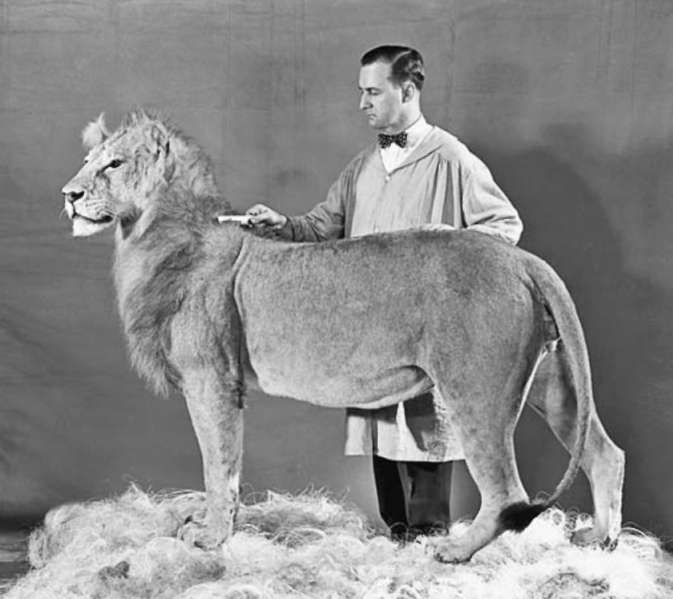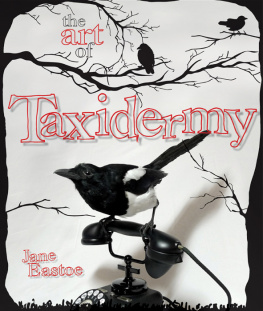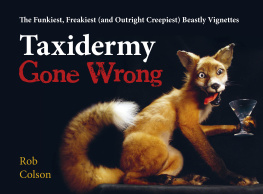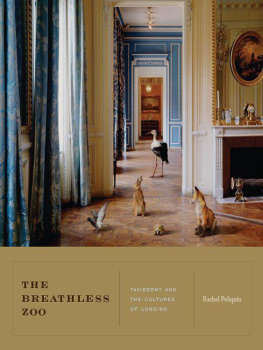
HOUGHTON MIFFLIN HARCOURT
BOSTON NEW YORK
2010
Copyright 2010 by Melissa Milgrom
All rights reserved
For information about permission to reproduce
selections from this book, write to Permissions,
Houghton Mifflin Harcourt Publishing Company,
215 Park Avenue South, New York, New York 10003.
www.hmhbooks.com
Library of Congress Cataloging-in-Publication Data
Milgrom, Melissa.
Still life : adventures in taxidermy / Melissa Milgrom.
p. cm.
ISBN 978-0-618-40547-3
1. TaxidermyAnecdotes. 2. TaxidermistsAnecdotes. I. Title.
QL 63. M 55 2010 590.75'2dc22
2009013511
Book design by Melissa Lotfy
Printed in the United States of America
DOC 10 9 8 7 6 5 4 3 2 1
"Oh Pretty Woman": words and music by Roy Orbison and Bill Dees. Copyright 1964 (renewed 1992) Roy Orbison Music Company, Barbara Orbison Music Company, and Sony/ATV Music Publishing LLC. All rights on behalf of Roy Orbison Music Company and Barbara Orbison Music Company administered by ICG. All rights on behalf of Sony/ATV Music Publishing LLC administered by Sony/ATV Music Publishing LLC, 8 Music Square West, Nashville, TN 37203. All rights reserved. Used by permission.
Frontispiece photograph: The American Museum of Natural History taxidermist James L. Clark grooming an Asiatic lion, 1930. Image #313279, American Museum of Natural History.
For my cubs,
Sabine and Greta
CONTENTS
SCHWENDEMAN'S TAXIDERMY STUDIO 1
THE CHAMPIONS 32
THE MAN WHO HUNTED FOR SCIENCE 68
HOW THE ORANGUTAN GOT ITS SKIN 90
THE CHAIRBITCH 122
MR. POTTER'S MUSEUM OF CURIOSITIES 160
IN-A-GADDA-DA-VIDA 191
KEN AND THE IRISH ELK 207
I STUFF A SQUIRREL 230
GRAY SQUIRREL, YELLOW DAWN 248
Sources 263
Acknowledgments 283
My hobby is stuffing thingsyou know, taxidermy.
NORMAN BATES , Psycho
They are the proof that something was there and no longer is. Like a stain. And the stillness of them is boggling. You can turn away but when you look back they'll still be there looking at you.
DIANE ARBUS , 1971
1. SCHWENDEMAN'S TAXIDERMY STUDIO
"T HE SIGHT OF a particularly fine animal, either alive or dead, excites within me feelings of admiration that often amount to genuine affection; and the study and preservation of such forms has for years been my chief delight." I'm quoting William Hornaday, the famous Smithsonian taxidermist and animal-rights activist, who wrote this in his 1891 manual, Taxidermy and Zoological Collecting. But the words could just as easily belong to David Schwendeman. Schwendeman was the last chief taxidermist ever employed by the American Museum of Natural History, where he worked for twenty-eight years. Schwendeman is eighty-five, long retired, and likely to show up at the taxidermy workshop his father opened in 1921 in Milltown, NewJersey, now run by his son Bruce. Lately, he says, he's lost his dexterity for taxidermy. Indeed, he says, he's skinned his very last squirrel. Then I show up at Schwendeman's Taxidermy Studio, and he's degreasing a Cooper's hawk, or sculpting a puma tail, or varnishing a boar's nose (to give it the "wet look"), or macerating a bison skull to remove the meat. "Macerating bison's one of the worst smells there is in taxidermy," he says with a devilish grin.
Although Schwendeman's simulations of nature are unsparingly sober, his own nature is curious and wry. Much to Bruce's chagrin, women find David charming, though he is rail thin and pink-complected and he complains that his "computer" has a tendency to backfire. He has fleecy white hair and eyes that work like automatic sensors, picking up every chipmunk and groundhog that scuttles past his yardalthough he's as likely to raise them as he is to trap them in a Havahart.
With his khaki shirts and trousers, zebra-striped toolbox, and pocketknife, Schwendeman resembles the archetypal taxidermist, and that's exactly what he is. Schwendeman grew up in a taxidermy studio, passionately devoted to the art and science of creating the illusion of life. In his prime, he strove for absolute realism, becoming the perfectionist his father never was and his son now strives to be. "I am skilled; my father is talented," says Bruce, deferring to the old man who had no use for school after his ninth-grade biology teacher mistook a starling for a flicker. That was that; Schwendeman has sided with the animals ever sincea prerequisite, it turns out, for all great taxidermists, then and now.
Although the outside world may dismiss taxidermy as the creepy sideline of the Deliverance set or an anachronistic throwback to the dusty diorama, inside Schwendeman's taxidermy is known as a unique talent that is generally misunderstood. "You have to have respect and intuition for the animals to bring out their best characteristics," says David. "You have to have the delicate finesse of a watchmaker and the brute strength of a blacksmith," says Bruce. "You have to be able to mount a hummingbird and an elephant." Mostly you have to imitate nature with a fidelity that verges on pathological.
Schwendeman's Taxidermy Studio is the oldest business in Milltown and, not surprisingly, the only place on Main Street that dispenses business cards from the jaws of a leathery old alligator. The workshop was established by Arthur Schwendeman, David's father (Pup-Pup), a habitual truant who learned taxidermy from a female teacher who bribed him with taxidermy lessons so that he'd stay in school instead of running off to fish or hunt. He barely finished the eighth grade. David's mother, Lillian (Mum-Mum), was a patriotic earth mother whose energy for preserving God's creatures was infinite. She was the skinner and made all the artificial ears until she died at age ninety-four. "What you need for this kind of work is a strong stomach and lots of patience, and I have both," she once said. A resourceful cook known to lie about her ingredients, Lillian marched in every Fourth of July parade beside the float carrying one of Arthur's deer heads. Today Bruce Schwendeman wields the calipers and the brain spoons in the studio.
From outside, the sleepy little storefront resembles every other building on Main Street: a 1930s clapboard with two large display windows. Inside, however, the place brims with natural wonders. It's a motionless zoo. Roughly one thousand dusty-eyed birds and exotic stuffed beasts roost on the countertops and hang from the ceiling and walls. It's so cluttered with mounted animals (and skeletons and strange tools) that no one's ever bothered to take an inventory. Some are faded relics from the 1920s; others are so vibrant you want to poke them to see if they will move. A great blue heron with outstretched wings held in place with long dressmaker pins sits on a table near a puma that looks ready to pounce. Intricate snake skeletons lie in long glass-fronted wooden display cabinets. A fluffy Dall sheep seems to have walked through the wall, its hind end hidden from view on the other side.
Once when I visited, 180 birds Bruce had salvaged from an old wildlife museum filled the front room. Another time I encountered a pack of deciduous-forest dwellers (beaver, raccoon, black bear, skunk, turkey vulture, chipmunk, rabbit) preserved at the request of Yale's Peabody Museum of Natural History, which planned to transport Connecticut to Greece for the 2004 Olympics.
I first found myself drawn to Schwendeman's Taxidermy Studio in 1994, when I returned from a trip to Africa to visit my in-laws, who lead safaris for Ker & Downey. The company was founded in 1946 by big-game hunters. Now it's conservation minded and has taken Meryl Streep, Prince Charles, and other famous people on safari in discreet comfort. But not, as it turned out, me.
Next page






